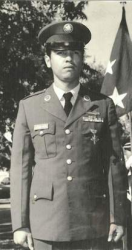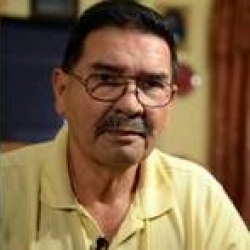
 |
|
|
||
|
Santiago Jesus Erevia |
||||
|
Engagements: • Vietnam War (1960 - 1973) |
||||
| Biography: | ||||
|
Santiago Jesus Erevia Santiago Jesus Erevia grew up on a farm in Nordheim, a small town southeast of San Antonio, TX. He picked cotton as a kid and went to school, where he excelled in math, but his dad made him quit as a high school sophomore. “I wanted to stay in school and he said, 'No, you can't,' and I said, 'OK, you're going to have a dumb son for not being a good father,'” Erevia said. Erevia worked as a laborer in a cotton gin. Sometimes, pickers would load cotton in a truck he'd drive to the field. He also would load up watermelons and drop bales of Johnson grass for cattle. Later, in the middle of a divorce, Erevia joined the U.S. Army in San Antonio when he was 22-years old, hoping to get his high school equivalency certificate and go to college — something he did along the way. On 21 May 1969 his unit, C Company, 1st Battalion, 501st Infantry, 101st Airborne Division, was on a search-and-destroy mission near Tam Ky City, a coastal town south of Da Nang, when things went wrong. “We were up against a culvert, there's a mountain here, we had to cross about 100 yards and the captain and his radio-telephone operator were pinned down,” Erevia said. “The captain said, 'Erevia, you and (another soldier) go up there and see what y'all can do.' So there was a tree about 30 yards from where the captain was, so we ran up towards the tree and we were back to back against the tree.” He cries when he talks about the friend who went with him into the battle. “You OK?” Erevia asked. “He never answered me.” Erevia left his buddy, who had been shot in the head, and fired two M-16 rifles while charging a bunker and tossing a grenade into it. “And then I went up behind another one, same thing. There was a total of five.” Crouched in the culvert, his captain saw most of the attack while a handful of other GIs witnessed what happened at the last bunker. “This guy was firing into the air,” Erevia said of the enemy soldier there. “That's what made it so dramatic, that five people were able to witness this. He popped out of the hole and he was firing up, and of course I got him with my M-16.” In 1970, Erevia left active service with a two year reserve obligation. In 1972 he joined the Texas National Guard and went on to serve 17 years. Despite his reservations about being awarded the Medal of Honor, Erevia will attend the White House ceremony. He is unlikely to hit the speaker circuit and instead will try to return to his quiet life and familiar routines. “They say you deserve it. I'll take it in stride. And I'll jump in joy,” Erevia said, “but I'm going to jump in joy by myself in the bedroom.” Post-Military Life Erevia went to work at the post office when he returned home from the Army and, after 32 years there, he retired in 2002. He has had health woes that included a heart attack. He likes to walk to a park on the South Side, and has gained enough strength to do 25 pushups. Medals, Awards & Badges Medal of Honor * * Medal of Honor Seeking to correct potential acts of bias spanning three wars, and following a Congressionally-mandated review to ensure that eligible veterans were not bypassed due to prejudice, the Medal of Honor will be awarded to 24 Army veterans. The unusual mass ceremony, scheduled for 18 March 2014, will honor veterans, most of Hispanic or Jewish heritage, who had already received the Distinguished Service Cross, the nation’s second-highest military award for valor. Only three of the recipients are living. The Army conducted the review under a directive from Congress in the 2002 National Defense Authorization Act. The law required that the record of each Jewish American and Hispanic American veteran who received a Distinguished Service Cross, during or after World War II, be reviewed for possible upgrade to the Medal of Honor. The Army reviewed the cases of the 6,505 recipients of the Distinguished Service Cross from World War II, Korea and Vietnam, and found an eligible pool of 600 soldiers who may have been Jewish or Hispanic. The Army also worked with the National Museum of American Jewish Military History, the Jewish War Veterans of the USA and the American GI Forum, the largest Hispanic-American veterans group, to pinpoint potential medal recipients. Of the 24, seven fought in World War II, nine in the Korean War, and eight in the Vietnam War. Since the award of the Medal of Honor is an upgrade to the Distinguished Service Cross already received by SP4 Erevia, it is based on the valorous actions in the Citation for his DSC. Distinguished Service Cross Citation: The President of the United States of America, authorized by Act of Congress July 9, 1918, takes pleasure in presenting the Distinguished Service Cross to Specialist Fourth Class Santiago Jesus Erevia, United States Army, for extraordinary heroism in connection with military operations involving conflict with an armed hostile force in the Republic of Vietnam. Specialist Fourth Class Erevia distinguished himself on 21 May 1969 while serving as a radio-telephone operator with Company C, 1st Battalion, 501st Infantry Regiment, 101st Airborne Division (Airmobile), during a search and clear mission near Tam Ky City in the Republic of Vietnam. After his platoon had penetrated an enemy defensive perimeter, Specialist Erevia was delegated to remain behind and care for the wounded while the rest of the platoon pushed on against the adversary. As Specialist Erevia began administering first aid to the battle casualties, their position came under heavy fire from a line of enemy bunkers to his left front. Without hesitation, Specialist Erevia crawled from one wounded man to another gathering weapons and ammunition. Armed with two M-16 rifles and several hand grenades, he then rose to his feet and charged directly into the fire of the hostile gun emplacement, discharging suppressive fire on the enemy as he ran. Once near the first bunker, Specialist Erevia edged his way up to the emplacement under intense fire from the other bunkers and unleashed a grenade on its defender. He then maneuvered to the second and third bunkers employing the same tactics and destroyed both fortifications and their occupants with well-placed grenades. His supply of hand grenades now exhausted, Specialist Erevia fought his way to the final bunker, running and firing both M-16 rifles simultaneously, and killed the fortification's defender with point-blank fire. Having single-handedly destroyed four enemy bunkers and their occupants, Specialist Fourth Class Erevia then returned to the soldiers charged to his care and resumed treating their injuries. Specialist Fourth Class Erevia's extraordinary heroism and devotion to duty were in keeping with the highest traditions of the military service and reflect great credit upon himself, his unit and the United States Army. |
||||
| Honoree ID: 228008 | Created by: MHOH | |||
Ribbons
Medals
Badges
Honoree Photos
 |  |  |
 |  |
 |


